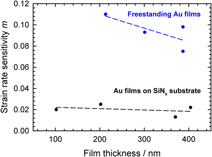Crossref Citations
This article has been cited by the following publications. This list is generated based on data provided by
Crossref.
Maier, Verena
Leitner, Alexander
Pippan, Reinhard
and
Kiener, Daniel
2015.
Thermally Activated Deformation Behavior of ufg-Au: Environmental Issues During Long-Term and High-Temperature Nanoindentation Testing.
JOM,
Vol. 67,
Issue. 12,
p.
2934.
Merle, Benoit
Nicholson, Kyle S.
Herbert, Erik G.
and
Göken, Mathias
2016.
An improved method for point deflection measurements on rectangular membranes.
Materials & Design,
Vol. 109,
Issue. ,
p.
485.
Karanjgaokar, Nikhil
and
Chasiotis, Ioannis
2016.
Creep behavior of nanocrystalline Au films as a function of temperature.
Journal of Materials Science,
Vol. 51,
Issue. 8,
p.
3701.
Maier-Kiener, Verena
and
Durst, Karsten
2017.
Advanced Nanoindentation Testing for Studying Strain-Rate Sensitivity and Activation Volume.
JOM,
Vol. 69,
Issue. 11,
p.
2246.
Mongkolsuttirat, K.
Smyth, J.R.
McLean, M.
Brown, W.L.
and
Vinci, R.P.
2019.
The effects of solid solution and oxide dispersion alloying on the viscoelastic behavior of Au alloy thin films.
Acta Materialia,
Vol. 168,
Issue. ,
p.
275.
Merle, Benoit
2019.
Creep behavior of gold thin films investigated by bulge testing at room and elevated temperature.
Journal of Materials Research,
Vol. 34,
Issue. 1,
p.
69.
Preiß, Eva I.
Lyu, Hao
Liebig, Jan P.
Richter, Gunther
Gannott, Florentina
Gruber, Patric A.
Göken, Mathias
Bitzek, Erik
and
Merle, Benoit
2019.
Microstructural dependence of the fracture toughness of metallic thin films: A bulge test and atomistic simulation study on single-crystalline and polycrystalline silver films.
Journal of Materials Research,
Vol. 34,
Issue. 20,
p.
3483.
Gupta, Saurabh
Stangebye, Sandra
Jungjohann, Katherine
Boyce, Brad
Zhu, Ting
Kacher, Josh
and
Pierron, Olivier N.
2020.
In situ TEM measurement of activation volume in ultrafine grained gold.
Nanoscale,
Vol. 12,
Issue. 13,
p.
7146.
Liebig, Jan P.
Mačković, Mirza
Spiecker, Erdmann
Göken, Mathias
and
Merle, Benoit
2021.
Grain boundary mediated plasticity: A blessing for the ductility of metallic thin films?.
Acta Materialia,
Vol. 215,
Issue. ,
p.
117079.
Hua, Anping
and
Zhao, Junhua
2022.
Shear direction induced transition mechanism from grain boundary migration to sliding in a cylindrical copper bicrystal.
International Journal of Plasticity,
Vol. 156,
Issue. ,
p.
103370.
Zhang, Yulong
Sun, Jianwen
Liu, Huiliang
and
Liu, Zewen
2022.
Modeling and Measurement of Thermal–Mechanical-Stress-Creep Effect for RF MEMS Switch Up to 200 °C.
Micromachines,
Vol. 13,
Issue. 2,
p.
166.
Zhang, Yulong
Sun, Jianwen
Liu, Huiliang
and
Liu, Zewen
2023.
Investigation of Thermal Creep in Metal-Based MEMS Cantilevers.
Journal of Microelectromechanical Systems,
Vol. 32,
Issue. 5,
p.
474.
Krapf, Anna
Gebhart, David D.
Gammer, Christoph
Cordill, Megan J.
and
Merle, Benoit
2023.
Creep-dominated fatigue of freestanding gold thin films studied by bulge testing.
Materials Science and Engineering: A,
Vol. 887,
Issue. ,
p.
145759.
Krapf, Anna
Merle, Benoit
Gebhart, David D.
Reiter, Marco
Lassnig, Alice
Göken, Mathias
Cordill, Megan J.
and
Gammer, Christoph
2024.
Observing High‐Cycle Fatigue Damage in Freestanding Gold Thin Films with Bulge Testing and Intermittent Transmission Electron Microscopy Imaging.
Advanced Engineering Materials,





